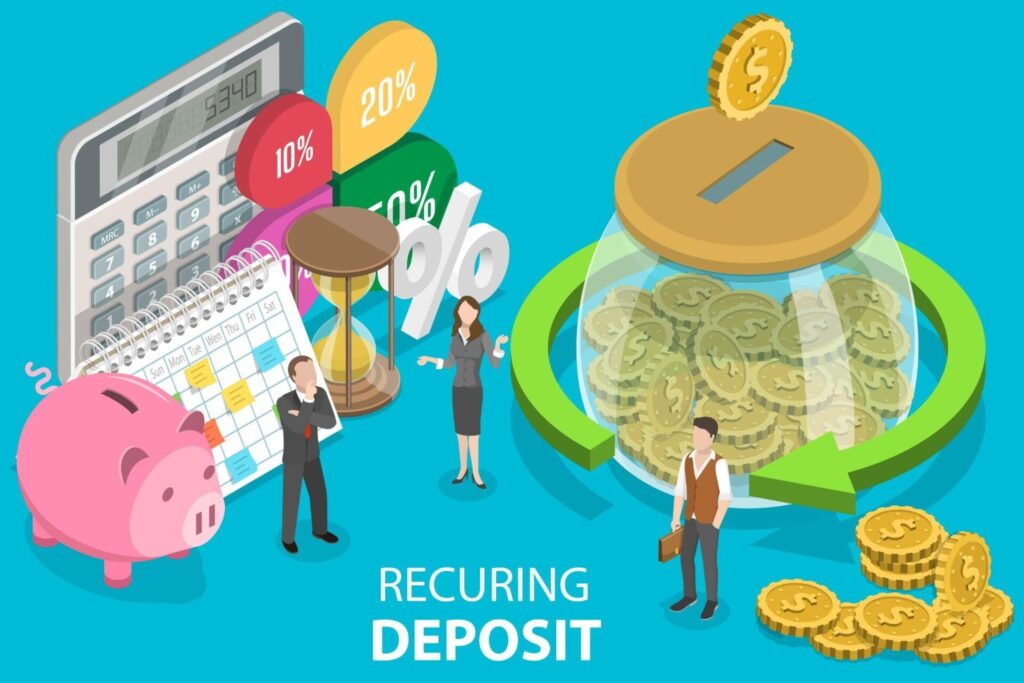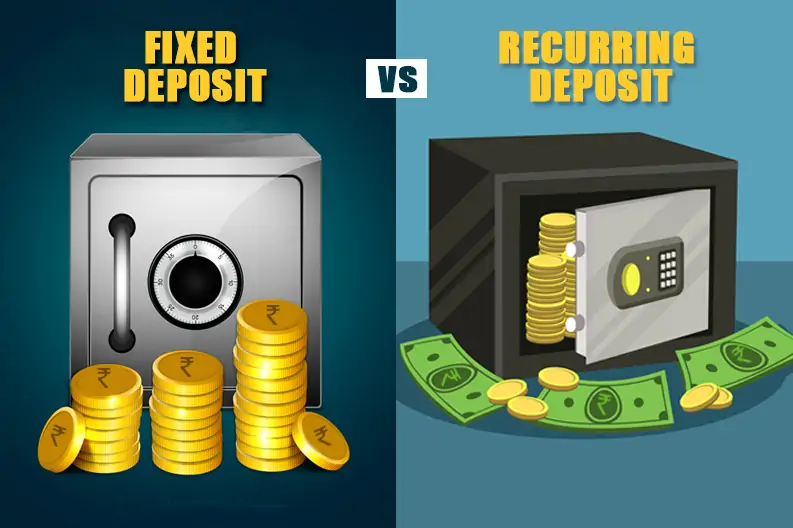What is a Recurring Deposit and How does it work?
Have you also wondered what is a recurring deposit and how it is different from other deposits? It’s a common query, hence we are going to solve it for you. A Recurring Deposit (RD) account serves as a financial tool enabling individuals to save money systematically over a designated duration through regular monthly investments. Investors have the flexibility to determine the deposit tenure and monthly contribution amount according to their preferences. While fixed deposits pay hire interest, RD schemes offer greater flexibility compared to fixed deposit schemes. This makes them popular among individuals looking to initiate savings and establish a contingency fund for unforeseen expenses.
These include individuals who just started earning or those with lower incomes. If you are not able to save up a large amount of money at once, then it is prudent to use recurring deposits to save and earn interest.
| Interest Rate | 2.5% to 7% |
| Minimum Monthly Deposit Amount | Rs.100 |
| Investment Tenure | 6 months to 10 years |
| Interest Compounding Frequency | Quarterly |
| Partial Withdrawal | Not allowed |
| Premature Withdrawal | Allowed subject to penalty |
Types of Recurring Deposits

- Regular RD Accounts: These accounts cater to Indian residents aged 18 or older. Monthly deposits, fixed in amount, are made over a predetermined period, earning a set interest rate. Interest can be calculated using either compound or simple methods, depending on the account’s duration. This option suits those seeking disciplined savings with a guaranteed return.
- RD Accounts for Minors: Minors, supervised by parents or guardians, can have accounts. Similar to regular RDs, they require fixed monthly deposits and predetermined tenures. Returns may slightly exceed regular RDs, making it a prudent choice for building a minor’s financial foundation.
- RD Accounts for Senior Citizens: Tailored for individuals aged 60 and above, these accounts offer additional benefits, including potentially higher interest rates compounded quarterly. This option provides senior citizens with a reliable source of income and financial security in retirement.
- NRE/NRO RD Accounts: NRIs can opt for NRE and NRO RD accounts, facilitating regular savings and interest earnings on income from both domestic and international sources. These accounts offer flexibility and convenience for NRIs looking to grow their savings while living abroad.
Top 15 Banks and Their RD Interest Rates
| Bank Name | Regular RD Interest Rates (% p.a.)* | Senior Citizen RD Interest Rates (% p.a.)* |
| DBS Bank | 2.50-5.50 | 2.50-5.50 |
| Citibank | 3.00-3.25 | 3.50-3.75 |
| Indian Bank | 3.95-5.25 | 4.45-5.75 |
| Bank of Baroda | 4.50-5.70 | 5.00-6.20 |
| HDFC Bank | 4.50-5.75 | 5.00-6.25 |
| ICICI Bank | 4.75-6.00 | 5.25-6.50 |
| UCO Bank | 4.95-5.00 | 5.25-5.50 |
| Kotak Bank | 5.00-5.50 | 5.50-6.00 |
| Bandhan Bank | 5.40-6.75 | 6.15-7.50 |
| Union Bank of India | 5.50-5.90 | 5.50-5.90 |
| Andhra Bank | 5.50-5.80 | 6.00-6.30 |
| Punjab National Bank | 5.50-5.80 | 6.00-6.30 |
| IDBI Bank | 5.75-5.90 | 6.25-6.40 |
| Indian Overseas Bank | 5.75-6.80 | 6.25-7.30 |
| Axis Bank | 6.05-6.50 | 6.55-7.00 |
| Post Office | 6.20 | 6.20 |
*Interest rates are subject to change with time.
How to Open an RD Account?
Online Application:
- Access your net banking or mobile banking account.
- Navigate to the option “Open an e-RD Account” on the dashboard.
- Enter the desired account number for instalment debiting, preferred instalment amount, and deposit period. Nominate a beneficiary and confirm agreement to terms and conditions.
- Review the maturity amount and agree to terms before submitting. Upon confirmation, the specified instalment will be deducted from the designated account.
- Receive a confirmation message and an email containing the RD receipt at the registered email address.
Offline Application:
- Go to the nearest bank branch where you hold a savings account.
- Complete the RD application form with details like instalment amount, payment method, tenure, and nominee information.
- Make the initial instalment payment via cheque or cash.
- Submit the application to the bank representative, who will process it within the specified timeframe.
Features of Recurring Deposit

- Invest a minimum of Rs.100 per month to open an RD account.
- The minimum deposit period for RD accounts is six months, extendable up to 10 years.
- Enjoy higher interest rates compared to savings accounts, typically compounded quarterly.
- RD accounts have a lock-in period of 30 days to 3 months, determined by the bank. No interest is earned if withdrawn within this period.
- A single individual can open multiple RD accounts as per their financial goals.
- Some banks and the Post Office allow advance deposits in RD accounts.
- Partial withdrawals are not permitted, but premature withdrawals can be made with a penalty.
- Unlike fixed deposits, RD accounts require monthly payments instead of lump-sum deposits.
- Set up standing instructions for automatic deduction of instalments from your savings account.
- Senior citizens may receive an additional 0.5% interest rate on their RD accounts.
- RD accounts can be opened for minors under parental or guardian supervision.
- Utilize overdraft or loan facilities against the RD balance for financial flexibility.
RD accounts offer a convenient way to save and earn interest regularly. With flexible deposit periods, higher interest rates, and the option for overdrafts, they cater to various financial needs. Whether saving for short-term goals or securing a child’s future, RD accounts provide stability and growth potential for investors. Like this post? Don’t forget to check out our other short stories in our Latest section

